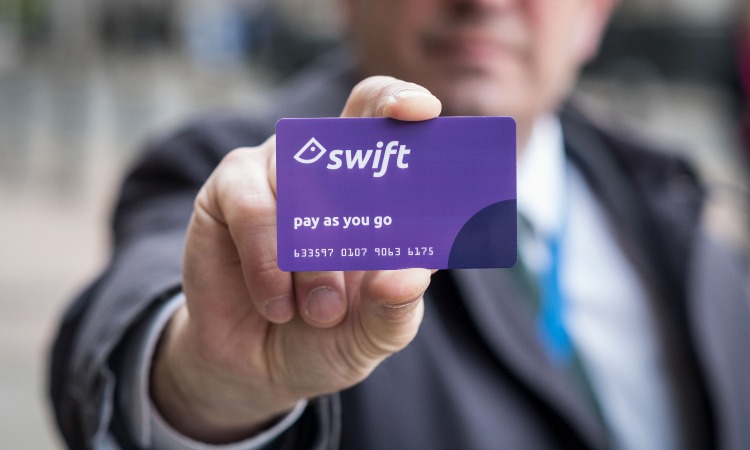MaaS and its endless possibilities for the transport industry
- Like
- Digg
- Del
- Tumblr
- VKontakte
- Buffer
- Love This
- Odnoklassniki
- Meneame
- Blogger
- Amazon
- Yahoo Mail
- Gmail
- AOL
- Newsvine
- HackerNews
- Evernote
- MySpace
- Mail.ru
- Viadeo
- Line
- Comments
- Yummly
- SMS
- Viber
- Telegram
- Subscribe
- Skype
- Facebook Messenger
- Kakao
- LiveJournal
- Yammer
- Edgar
- Fintel
- Mix
- Instapaper
- Copy Link
Posted: 13 April 2023 | James Bullen - Transport for West Midlands | No comments yet
James Bullen, MaaS Project Lead at Transport for West Midlands (TfWM), discusses the intricacies of developing Mobility-as-a-Service systems that works seamlessly across all transport modes with Intelligent Transport’s Leah Hockley, and explains why it is reaching such an exciting point for the industry.


What role does MaaS play in the West Midlands?
When we look at all of the mobility modes, Mobility-as-a-Service really is the glue in trying to bring them all together into one platform”
At Transport for West Midlands (TfWM), we work across many transport modes. I sit in TfWM’s Innovation Team, and we look across the whole lifecycle of user journeys through all modes that people have access to in our region, including newer modes – such as micro-mobility and Demand-Responsive Transport (DRT) – alongside the backbone of public transport, with bus, train and tram; and the active network for walking, wheeling and cycling. When we look at all of the mobility modes, Mobility-as-a-Service (MaaS) really is the glue in trying to bring them all together into one platform. As we know, that is essentially the aim of MaaS – to bring together those various modes – and we see it as a tool to impact behaviour, as well.
Going forward, once you’ve got the information that you need from all of the various modes, and once the user can plan, book and pay for those modes together, then we need to be looking at what more can be done with the product. How can we bring rewards and incentives in? How can we use those as a tool to reach our policy goals, as well as societal goals such as reducing emissions and access to opportunities? It’s an exciting time, and MaaS has so many possibilities for our industry.
Have you found that these newer forms of mobility play a key role, beyond just standard fixed-route services?
I definitely see mobility becoming more dynamic. In the past, it has been a ‘provide a service and the people will come’ type of approach, but this is really changing now. We see that with other industries, with services such as Netflix and Spotify, where people are subscribing to a service. Even IKEA now rents out furniture on a ‘subscription-like’ model. While transport is not quite there yet, I really think that the ownership model is changing, so much so that people won’t want to own a car in the future. They’ll just want access to use a car.
We’ve offered subscription services for a while, but it has just been siloed in its particular mode: when you buy a season pass for a bus or a train, which people do quite a lot, in a way, that is like a subscription. The idea of joining it up across transport modes is key, and is the next step for us to take.
How is TfWM using MaaS to make public transport more accessible?
Firstly, we have been carrying out exercises to understand the people in our region. We’ve built up personas, we’ve built up segmentation and we’ve done so with the whole population of the West Midlands. As we’re developing MaaS, we’ve been looking at those different segmentations, considering who might be the early adopters; who might be harder to reach; what types of people are already using products today, that would hopefully then be transferred to this new MaaS product.
We have been carrying out exercises to understand the people in our region… As we’re developing MaaS, we’ve been looking at those different segmentations, considering who might be the early adopters; who might be harder to reach”
When we consider accessibility, the first part is understanding people and what their movements are. For example, part of the segmentation is in looking at a standard week for different individuals.
We need to consider people’s needs. If they have children, they might have a lot of baggage – and it’s these sorts of pain points in people’s travel needs that we need to understand better. That’s where we can actually use the data to link into new services, explore what they look like and which services should be put in place.
For example, we’re currently developing mobility hubs and, in particular, looking at where we put those mobility hubs. Part of this is looking at areas of deprivation and linking those people to employment and education. I think that MaaS’ role in this is just like a data collection tool – seeing where people are going from and to, and also where people want to go from and to, as well. One of our ideas is that, through the MaaS app, users would be able to give feedback and suggest a particular service to be in their area because it’s not currently. I think that MaaS could be a really good mechanism for users to have an active say.


How significant a role does MaaS play in developing a more sustainable transport system?
I believe that MaaS plays a really significant role in the sustainability of our industry. It’s not a silver bullet but, like I said earlier, it really gives us a tool to start nudging user behaviours. There’s a lot of talk about getting people out of their private car or scrapping the car altogether, but for me, that’s a really extreme change in behaviour. Realistically, people are quite unlikely to do that. What they are more likely to do is to get rid of their second car, or substitute some of the trips that they usually take in the car each week with a different mode. Added up, that could still be a big win for us as an industry.
I believe that MaaS plays a really significant role in the sustainability of our industry. It’s not a silver bullet but… it really gives us a tool to start nudging user behaviours”
For me, the realm of being able to access a car, but not own it, is really critical, as well. Lift-sharing and ride-sharing ideas have so much space to grow, and MaaS can be a tool to encourage people to this. Many people I speak to day-to-day that don’t work in transport simply don’t know that these exist as an option, and this is something that we need to change.
MaaS is also a fantastic tool to highlight the emissions associated with each trip. Throughout the solution demonstrations that we had with customers, it was clear that this was a feature that they all valued and wanted as part of the app. We could provide users with the ability to sort trips by the lowest number of emissions. Others may wish to sort trips by other factors, such as the least expensive, or the fastest, for example, but the key point is giving users the ability to access and view trips in the way that they want to, through a MaaS service.
Let’s consider the ‘Your Year in Review’ on Spotify. It provides an individual with analytics on what they’ve been listening to, their favourite artist, favourite genres and so on. I believe that we could do something similar for transport. For instance, how many miles have you travelled? What modes have you used? How long have you spent on each mode? What carbon emissions savings have you made? Once a MaaS system is set up, you can test these certain interventions and see if they have an impact.
It’s about creating that personalised experience, which, although not easy, will bring significant opportunities.
How far do you think the industry has come in incorporating MaaS into existing mobility networks?
I think it’s fair to say that we’ve seen excessive hype around MaaS and what it could potentially do. I’d argue that we’ve now dropped down into the trough of disillusionment, where you’re not sure if the hype is going to actually be realised. However, there is so much work happening right now, today. The industry is not shouting so much about it, but they’re doing a lot.
We have all of the components [of MaaS]… But it’s about bringing all of those together and seeing it on scale. That is the final piece of the jigsaw – and I am confident that it will happen”
MaaS schemes are in place. Many pilots and trials, and some bigger scale projects, are starting to come into place as well now. Data is being collected on how successful MaaS is or not, and with different business models, with different incentives, etc.
I work in MaaS day-to-day and speak a lot with other regions that are developing MaaS. I know for a fact that everyone’s working really hard, and it’s really exciting. But, seeing those results on scale hasn’t quite happened yet. We have all of the aspects of the backbone of MaaS, when you consider journey planning; ability to book; ability to pay; ticketing, as well. We have all of the components, we have all of the modes, and there are even new modes coming in. But, as I mentioned earlier, it’s about bringing all of those together and seeing it on scale. That is the final piece of the jigsaw – and I am confident that it will happen.


Credit: West Midlands Combined Authority
Do have any future projects planned to further foster MaaS development and deployment?
We have the existing Swift system in place in the West Midlands, encompassing smart ticketing and the ability to plan, book and pay for some services on that system. We already have a front-end user interface through both websites and apps. Looking ahead, we would look to transition from that to a new MaaS system and user interface, which would incorporate more modes and ticketing options.
We need to think about how we link up the digital infrastructure of MaaS and the physical infrastructure of mobility hubs”
Looking to the future more broadly, we’re working on a Future Transport Zone (FTZ), and also our role in terms of contactless ticketing. There are many separate projects in the background. But, clearly, we need to think about how we link up the digital infrastructure of MaaS and the physical infrastructure of mobility hubs. I’ve seen some great case studies using QR codes to scan and download the app. Also, the ability to highlight mobility hubs and where they are in a MaaS app. Watch this space!
In an ideal world, what do you see the future of Mobility-as-a-Service looking like? Is it going to be a really key part of our future transportation networks?
I think the future of MaaS is exciting. Firstly, there is a lot of work to do by all players, and there are many key stakeholders involved in developing the future of MaaS.
Considering the levels of MaaS, you ideally want to reach Level Four, which is a place of incentivisation or rewards and of linking in key business travel. We’ve been speaking to our operators about their Business to Business (B2B) sales in terms of bulk tickets, and considering how we can integrate that into MaaS, as well. That presents another exciting area which I believe MaaS can develop in and deliver more for businesses.


Related topics
Accessibility, Journey Planning, Mobility Services, On-Demand Transport, Passenger Experience, Public Transport, Sustainable Urban Transport, Ticketing & Payments
Related modes
Bikes & Scooters, Bus & Coach, Metro, Rail
Related cities
West Midlands
Related countries
United Kingdom
Related organisations
Transport for West Midlands (TfWM), West Midlands Combined Authority (WMCA)
Related people
James Bullen








